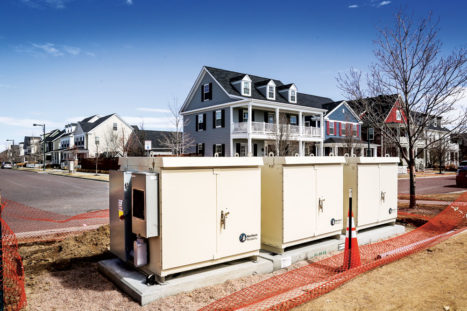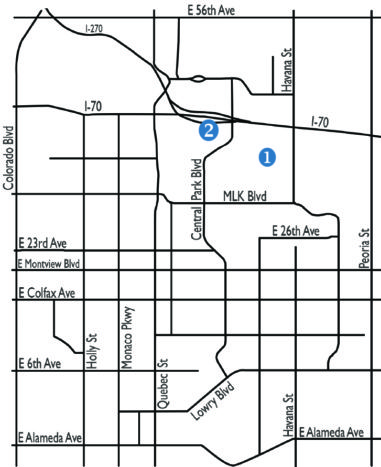1.) What are those tan utility boxes popping up around Stapleton?
The 60” x 52 x 53” tan metal boxes are power storage batteries that are part of a pilot project being conducted by Xcel Energy. Landscaping will be installed to partially screen them. Twelve boxes have been installed in groups of one, two, or three in North Central Park and Eastbridge. These neighborhoods were chosen because they have a higher than average number of homes with rooftop solar systems. Homes with rooftop solar sometimes put energy back into the grid and sometimes draw energy from the grid. This changes the way utilities provide power for customers—and many utilities around the country are now working to add more localized systems that can store energy and respond quickly to customers’ power needs.
Tyler McGrath of Xcel Energy explains that such energy storage batteries, which used to be prohibitively expensive, are now becoming available at a cost that makes wider use possible. To illustrate the rate of change, he points out that about 1,000MWh (megawatt hours) of battery storage units were installed in the U.S. from 2013 to 2017 and in 2018 another 1,000MWh of projects are in development.
What about safety?
McGrath says bollards will be installed around the batteries to protect them, should a car go off the road. In addition, the boxes themselves are very rugged, built to last 10 years, and the batteries are contained in an additional protective box inside. “They are made of common equipment put together in new ways,” he says. The batteries are like big computer batteries—and they do not emit radiation. The components are common parts that have been verified for safety and used in household appliances, among other uses, for years. The most sophisticated part of them, he says, is the software.
What is the pilot project testing?
The project is studying the impact of batteries on three factors:
Solar time shifting—The batteries can capture the excess energy that’s produced during the middle of the day when the local demand is low and then shift it to either morning or evening when there’s much higher demand. Local renewable energy then is being used when it’s most needed and the demand on the main power plant is more level.
Voltage regulation—Providing power not only means avoiding power outages, but also providing reliable voltage. Appliances and equipment rely on a consistent voltage, voltage variations can cause lights to flicker or even cause devices to not operate. If voltage variations occur, Xcel Energy can use the battery and the inverters to regulate the system within an acceptable range.
System Peak Demand Reduction (peak demand refers to highest amount of power a system needs to supply at a given time)—Peak demand for power is usually in the summer months around 7pm for this area. The Xcel Energy Control Center monitors the energy used across its service territory. If there is a very high demand for power, a signal can be sent for the batteries to discharge energy onto the grid to help lower that demand.

Three batteries were installed at 33rd and Beeler. All the boxes will be landscaped to help screen them from view.
How much power can these batteries store?
Each cabinet can store 18 kilowatts (KW) of power, which is the approximate amount of power produced by six homes with rooftop solar panels. With 12 cabinets, the project can store up to 216KW of power. (A 2015 comparison of average residential energy use showed that Colorado homes average 723 kilowatt hours per month, placing us 37th in the nation for amount used. www.electricchoice.com/blog/electricity-on-average-do-homes/)
Another Xcel Energy pilot project in Stapleton
In a separate pilot project, six homeowners were selected to have 15.5KWh storage batteries installed at their homes so Xcel can study their use. At the end of the two-year pilot, those homeowners can take ownership of the batteries for their expected 10-year lifespan or have them removed. The two studies are separate but both were placed in Stapleton for more efficient use of staff who are working on both projects.
2.) A Line Quiet Zone Update
Editor’s Note: See separate updated article “PUC Ruling Moves A Line Closer to Quiet Zones.” The PUC ruled to allow extended times at crossing gates and removal of crossing attendants, which allows RTD to request quiet zone approval from the Federal Railroad Administration.
As reported last month, a request to amend previously approved times at A Line crossing gates, adding up to 15 additional seconds, has been awaiting approval from the Public Utilities Commission (PUC) since last fall. They initially denied the request, then determined the issue would be researched by an administrative law judge, who would make a recommendation to the PUC. That judge held hearings in February.
Shortly before going to press, we learned that the PUC scheduled deliberations on A and G line crossing matters for March 28 at 1:30pm. The meeting will be streamed live. The webcast link is at https://www.colorado.gov/dora/puc. Front Porch will post the outcome of the meeting on FaceBook and our website, FrontPorchNE.com.
We questioned the city on what happens if the outcome is not favorable. Nancy Kuhn from Denver Public Works said by email, “the city will evaluate its options.” We also asked if the city can proceed with a Quiet Zone application anyway. “The city may have the legal authority to proceed with quiet zone application. However, the City is not aware of a circumstance in which the FRA has permitted a quiet zone where the crossing design is not yet final.” The PUC can notify the FRA “of the non-final character of crossings at issue. Beyond this, the City has not fully examined the ramifications or unintended consequences of establishing quiet zones before the PUC approves final A Line crossing designs, including covering any transfer of liability to Denver taxpayers,” said Kuhn. Following a favorable decision, Kuhn said, “The city is prepared to submit paperwork that will establish quiet zones… It could take ten weeks or longer depending on the order itself.”
3.) A Cold Car or No Car?
Compared to the same period last year, car thefts have increased almost 15 percent in Denver but nearly 78 percent in Denver Police Department’s District 5, which covers Stapleton, Montbello and Green Valley Ranch. One of the largest categories of this crime is the theft of running vehicles with keys left inside them, which police refer to as “puffing.”
“The puffers are killing us,” says Lt. Ian Culverhouse of District 5. “Year to date, we’ve had 162 steals, of which 61 were puffers, so almost 38 percent,” Culverhouse added at a mid-March interview.
The most often stolen vehicles are Hondas, and Fords are a frequent target among trucks, according to Culverhouse. While 83 percent of stolen vehicles in District 5 are recovered, some are returned in poor shape – and some are even totaled – so avoiding theft in the first place by not leaving a car running is key.
“If you’re going to warm up the car, stay with the car,” said Culverhouse. “I realize it’s a challenge and people don’t want to go out to a cold car, but at the end of the day, would you rather have a cold car or no car?”
Devices called Clubs that prevent the steering wheel from turning are available upon request from District 5 for the most targeted makes of Hondas, Fords and Subarus. For information about how to get a club, contact Community Resource Officer (CRO) Marika Putnam at 720.913.1405 or by email at marika.putnam@denvergov.org.




0 Comments